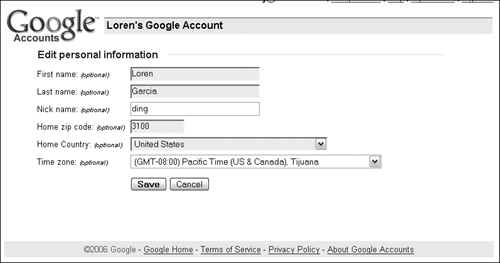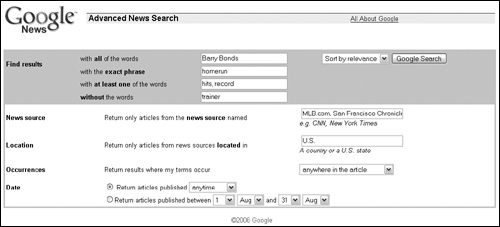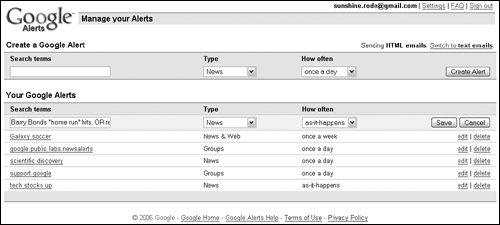Learn to sign up for Alerts
Learn about News Alerts
Make use of Web Alerts
How to use Groups Alerts
Learn about managing Alerts
In this day and age, finding time to read the newspaper, watch the news, or listen to the radio is difficult. Still, it’s important to keep track of the news, information found on the Web, or posted in the Usenet News groups. Even when you have time to read the newspaper or news Web site in the morning, keeping abreast of the news throughout the day can be difficult. Google has developed E-mail Alerts for anyone that needs to stay on top of the latest news or events happening around them. Because most people now read their e-mail throughout the day, getting special news alerts in your e-mail is a great way to stay abreast of changing information.
E-mail alerts are saved topic searches through Google News, Google Groups, or the Web on topics you choose. When those searches meet a threshold of relevance, an alert is sent to your e-mail account letting you know about the information that triggered the alert.
By signing up for Google E-mail Alerts, Google sends information and news directly to you by e-mail. You decide the topic of the E-mail Alert and how often you want Google to send it. There are four types of Google E-mail Alerts:
News: Every time your selected topic makes it into the top ten news articles through your saved Google News search, you receive the alert.
Web: When the top 20 search results for your Web topic search change, a Google E-mail Alert is sent to you.
News and Web: This is a combination of News and Web alerts. When your topic search results in hits from either of these two lists, you will you receive an e-mail alert.
Groups: When you subscribe to a Google group, you can add an alert so that you get an e-mail when there is a new post to that group.
Cross-Ref
To learn more about Google News, see Chapter 14.
If you’re like most people, you get a lot of e-mail, some of it from people you know and some from people you wish would not send you e-mail. However, with the amount of e-mail most people get, sensitivity to the number of e-mail messages you receive has grown. You can choose how often you want Google to send you an alert by selecting one of these options:
Once a day: Each day Google sends you an e-mail when your topic triggers an alert sometime throughout the day.
As-it-happens: Google sends you the alert immediately each time your topic triggers the alert.
Once a week: You receive a single weekly e-mail from Google combining all the alerts that have accumulated throughout the week.
Signing up for alerts is simple. Having a Google Account in order to sign up for Google Alerts is not necessary, but recommended. You can manage your Google E-mail alerts easier using your Google account as well as take advantage of the other features that Google offers.
Having a Google Account is useful for using many of the Google applications, not just Google Alerts. It’s highly recommended that you sign up for your own Google Account. They are free and it’s easy to sign up. Point your browser to www.google.com/accounts/ManageAccount. This link takes you to the Google Accounts home page where you can create and also later access your account once it’s set up.
Another way to sign up for a Google Account is by going to the Google home page (www.google.com) and clicking on the Sign-in link in the top-right corner of the page. Clicking this link takes you to the Google Accounts page. Click the Create an account now link located on the right side of the page and below the question “Don’t have a Google Account?” You are then asked to provide the following information:
Your current e-mail address: Use the e-mail address you want your Google Account linked with.
Choose a password: You must type a password that is a minimum of six characters. Next to the box where you type the password you see a rating of your password’s security.
Re-enter password: Retype the password you typed in the previous step exactly the same.
Remember me on this computer: When you check this box, Google will not ask you for your password again (unless you erase the cookie file).
Enable Personalize Search: Another advanced feature of Google that keeps track of your searches launched from any Google page (Web pages, books, news). By keeping track, Google uses this information to recommend future searches and displays the results based on all your past searches.
Location: Choose your location from the drop-down list.
Word Verification: Type the graphic characters you see displayed in the box. Google uses this feature for protection from spammers.
Terms of service: You must accept the terms of service in order to create an account. To read the terms of service click the link to Google’s Privacy Policy. Accept the terms of service and privacy policy by clicking
I accept Create my Account.
Google must verify your e-mail address before your account becomes active and does so by sending you an e-mail to the address you typed while signing up. You receive an e-mail with the subject: Google Email Verification. This e-mail message contains a link to verify your e-mail address and complete your Google account signup.
When you click the link or copy and paste the link into a Web browser, a Web page opens where you will see the message: Email Address Verified. You are ready to use your Google account.
Log in to your account by clicking the Click here to manage your account profile link or click the Sign-in link in the top-right corner of the Google home page.
Your Google Account page contains several sections including Personal information, My Services, and when entered, Default payment method and Default shipping address..
Click the Edit link beside Personal Information, as shown in Figure 10.1, to change your name, nickname, e-mail address, home country and time zone. Click the Change password link to change your password. Additionally, you can change your security question by clicking the Change security question link.
Tip
It is good computer security practice to regularly change your password. Make them at least six characters long. Use upper and lower case characters and include numbers for maximum security.
My Services displays the Google services for which you have signed up. When you click the Edit link found next to “My services” on your Google Account page, you are taken to the Edit services page, where you can choose to delete some of the services you’ve signed up for or choose to delete your entire Google account.
Once you’ve signed up for a Google Account You can sign up for Google alerts directly from your Google Account page or from the Google Alerts home page. To create an alert, follow these steps:
Look for the Alerts link in the Try something new section to create new alerts, and when you already have alerts, click the Alert link in the My Services section. You can also create or add alerts from Google E-mail Alert accounts. Go to the Google Alerts home page by clicking the More link on the Google home page, then click Even More, then Alerts. If you are not signed into your Google account automatically, type your user name and password, and click the Sign in button.
From the Manage your Alerts page you can create a new alert and see a list of alerts previously created by you. Enter search terms in the Search terms box. Select a search term as though you were doing a Google search in a normal Google search box.
Select the Google services you would like to search in order to receive an alert from the Type selection list. Choose: News, Blogs, Web, Groups, or to search all of them, Comprehensive.
Select how often you want to receive the alert by choosing a frequency from the How often selection list.
Click Create Alert.
Once you complete this brief process you begin receiving alerts according to the schedule you specified.
When you create a Google News Alert, you can be sure you will be up-to-date with the latest news in the topic of your choice. Google continuously searches thousands of news sources to compile the top stories on its Google News page. Google searches more than 4,500 news sources using the search terms specified in your alert. When Google finds your search terms located in one of the top ten news stories, you receive a News Alert.
The News Alert is a great way to stay connected to the news without having to repeatedly scan the news on your own. Because Google Alerts creates an alert each time your topic of interest makes the news and sends it to you in an e-mail, based on the frequency specified in the alert, you never have to worry about missing this information.
Alerts can be created for a wide variety of topics, including sports news, financial news, and general news for a specific country or region. Creating alerts to search for very specific information can get a little tricky. For assistance in creating complex alerts use Google Advanced Search to create the perfect alert.
Create an alert to be notified when specific information about a particular topic is posted on the Internet in a news article, in a Google Group, or on the Web. Create advance Google Alerts to focus your search, and thereby receiving exactly the information you want as an alert. The process is very similar to performing advanced searches through any of the other Google services, such as the Google Web search. The following is an example of creating an advanced News Alert. You can follow similar steps for creating Web and Group Alerts.
Here are the steps for creating the example Advanced News Alert shown in Figure 10.2:
Click the Advanced news search link found on the Google News page (http://news.google.com).
In the “Find results” area, type Barry Bonds in the with all the words box.
Type home run in the with the exact phrase box.
In the with at least one of these words box, type hits, record.
In the without the words box, type trainer.
In the News source box type MLB.com, San Francisco Chronicle, Reuters, CNN.
In the Location box, type U.S.
The last two boxes, Occurrences and Date are not important for you to create your alert so leave them unchanged.
After completing step 9, you will be on the search results page. The search box contains a search string created from the information you specified when completing the Advanced News search page. Copy the search string found in the Google News search box. The example in the above steps creates a search string that looks like this: “Barry Bonds “home run” hits, OR record -trainer source:MLB.com, San Francisco Chronicle, Reuters, cnn location:usa”.
Go to your Alerts home page. The Google News search results page will have a link to My Account located in the upper right corner of the page.
In the Search terms box on the Create a Google Alert page, paste the search string copied from step 10.
Select a service to search from the Type selection list. For this example, select News.
Choose a frequency from the How often selection list. For this example, choose as-it-happens.
Click Create Alert.
In this example you have created an Advanced News Alert. The following table (Table 10.1) shows the string taken from the News page divided into different parts and a description of what it does.
Table 10.1. Analyzing the Example Search String
String | Function |
|---|---|
Barry Bonds | Tells Google you are looking for information about Barry Bonds. |
“home run” | Google will search for the exact phrase home run. The main topic of interest is home runs hit by Barry Bonds. |
hits or record | In this alert you are interested in knowing when Barry hits another home run and if he breaks another record. |
trainer | Exclude alerts about Barry Bonds’ trainer. Each time news breaks about Barry Bonds you will not receive an alert when the article includes anything about his trainer. |
source:MLB.com, San Francisco Chronicle, Reuters, CNN | You have told Google to find news from these sources. |
Location:U.S. | This specifies that only news generated in the U.S. will trigger the alert. |
It’s a good idea to use Advanced Alerts when you find yourself receiving e-mail not related to the exact topic you were hoping to be alerted about.
Google Groups contains information published through Usenet news groups on the Internet. Google Groups is one interface to that system and tracking information in some of these groups can prove to be very important. Many of the Google Groups contain important technical and business information. Searches through Google Groups can support research performed using Google Finance (http://finance.google.com).
Cross-Ref
Find more information about Google Finance in Chapter 16.
When you follow the postings in more than a single news group, keeping track of these posts can become a complex and time-consuming task. Thanks to Google’s technology and Google Alerts, tracking the information posted in Google Groups becomes easier. Similar to Google News Alerts, you can receive an alert each time something is posted to the groups you specify that match your topic search.
To create a Google Group alert, navigate to the Google Alerts page. On the Manage your Alerts page, type a search term. For the Type, select Groups. Select how often you want to receive the alert and click Create Alert. The new alert then appears in the list of alerts displayed in the Your Google Alerts section of the page. From this section you can choose to edit the alert or delete it completely.
When you receive Google Alerts in e-mail you are given the option of deleting the alert directly from the e-mail message by clicking the link provided in the e-mail. Without a Google Account, the only way to manage alerts is to delete them and create new ones.
A more efficient way of managing your Google Alerts is to sign into your Google Account and choose the Manage link next to the Alerts link found in the My Services section of your Google Account home page.
The Google Alert Manage your Alerts page is divided into two sections: Create a Google Alert and Your Google Alerts. In these two sections you can choose to create new alerts of any type, edit them, and delete them. Remember that deleting an alert cancels the alert, and you no longer receive alerts from deleted alerts.
Manage alerts you’ve created previously in the Your Google Alerts section. The alerts are displayed in a table with the following three columns:
Search terms: Contains which keywords and phrases you used to create the Google Alert
Type: Specifies the source of the information used to trigger the alert
How often: Specifies the frequency with which you receive the alert
To the left of the alert information are two links: one to edit the alert and the other link to delete the alert.
You can change your alerts by clicking the edit link. After clicking this link the three columns (Search terms, Type, and How often) change so that they can be edited. You can add, delete, or change the Search terms, and select a different type and change how often you receive alerts. Figure 10.3 shows you an alert in edit mode.
When you finish editing the alert, click Save. To leave it unchanged click Cancel.
Tip
By default, you receive all Google Alerts in HTML form. You can switch to text e-mail by clicking the switch to text emails link located in the upper-right side of the page. There is no way to change an individual alert from HTML to text e-mail. You must change all your alerts from one type to the other.
E-mail Alerts are a great way to keep track of changing information found in the news, the Web, and in Google Groups. Creating an alert is simple but creating a focused alert takes a little bit of work, but is made simpler by using the Advanced Search pages in each of the different information sources to create more focused search strings. Once you’ve created an alert, you can manage the alert from your Google Account or simply delete it.



